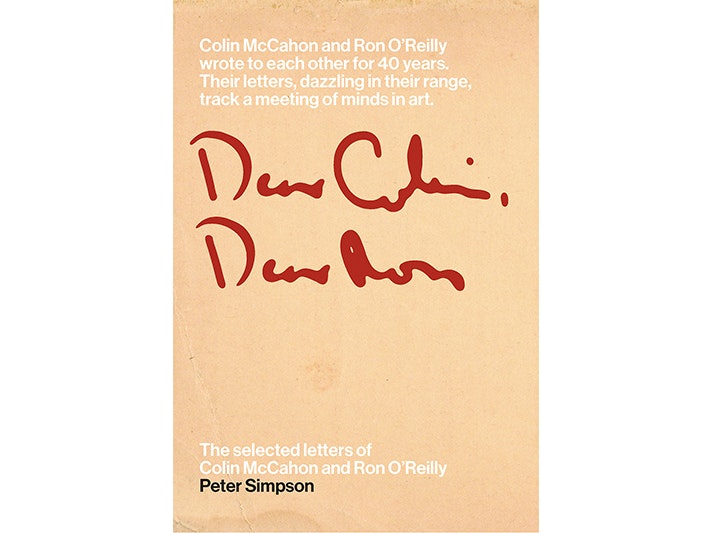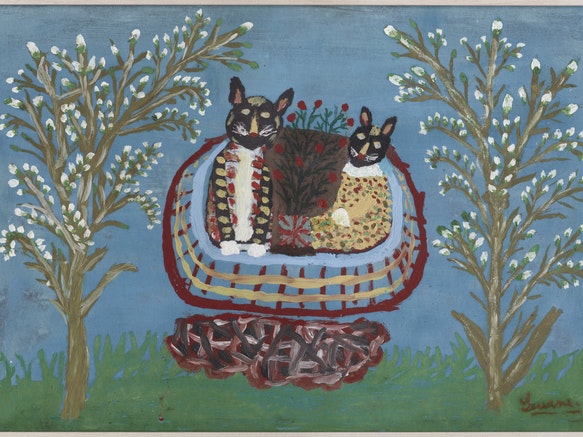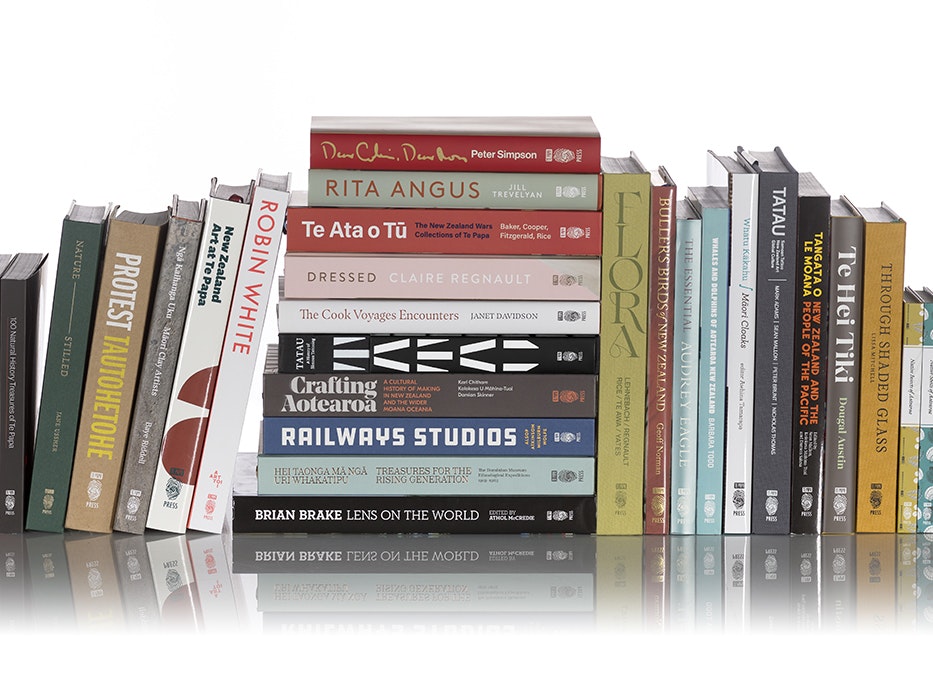
Dear Colin, Dear Ron: The Selected Letters of Colin McCahon and Ron O’Reilly
A long friendship in art and ideas through letters.
Free museum entry for New Zealanders and people living in New Zealand
Open every day 10am-6pm
(except Christmas Day)
Free museum entry for New Zealanders and people living in New Zealand
Peter Simpson, discusses Dear Colin, Dear Ron with Te Papa Press.
Peter Simpson was Associate Professor in the Department of English at the University of Auckland for 30 years. He is one of this country’s most experienced and prolific writers on art. He has curated three significant exhibitions of McCahon’s art and among his many books are a major two-volume work on McCahon. He writes regularly for Art New Zealand and major art catalogues. In 2017 he received the Prime Minister’s Award for Literary Achievement.
I’ve been familiar with Colin McCahon’s letters to Ron O’Reilly for more than twenty years and have drawn on them for several books and essays prior to this one, including Colin McCahon: The Titirangi Years 1953-59 (Auckland University Press 2007) and my two-volume study of McCahon, Colin McCahon: There Is Only One Direction, and Colin McCahon: Is This the Promised Land? published by AUP in 2019-20. Since this latter pair covered the whole of McCahon’s career I read, for the first time, all of his letters to Ron – about 190 letters covering the period 1946 to 1980 – and realised just how special they were as an insight into his life and art. At that stage Colin’s letters were in the possession of Ron’s son Matthew (they are now deposited in the Hocken Collections), and it was due to his generosity (and that of his sister Rachel) that I was able view the letters, copy parts of them and photograph them for later transcription. However, it wasn’t until 2021 that I was able to read the O’Reilly side of the correspondence (written over a slightly longer period, 1944-81) held in the McCahon papers at the Hocken Collections in Dunedin. Because of travel restrictions during the Covid epidemic I was unable to view the letters in person, but Hocken staff generously scanned the whole file and sent it to me thus enabling me to work on it at my leisure. As I read through Ron’s side of the correspondence in 2021, and discovered the fascination of their exchanges and reciprocal responses, I first conceived of publishing the whole correspondence (or at least a substantial portion of it) and began the marathon task of transcribing the letters in full.
The book as published includes around 380 letters spread over 37 years from 1944 to 1981. Only a very few trivial notes have been excluded. Most of the letters are published in full but some have been shortened by varying amounts in order: 1) to keep the overall size of the book manageable, 2) to preserve a reasonable balance between the two correspondents (O’Reilly’s letters tend to be longer than McCahon’s), and 3) to focus the contents on the material of greatest interest to a contemporary readership – specifically the visual arts in general and McCahon’s art in particular. Coincidentally, there is an almost exactly equal number of surviving letters from each writer. One can only speculate about the number of letters which were not preserved, but it is obvious from internal evidence that some are missing or incomplete (such as, for example, allusions in one letter to the contents of a previous letter from the other which has not survived), but my considered impression is that the great majority of their respective letters was preserved. Each of them highly valued the other’s letters and took care in their preservation, though obviously some slipped through the net. There are letters for every year between 1944 and 1981 except for two gaps, one in 1952 when both Ron and Colin were living in Christchurch and had no need to write to each other, and one in 1965, when Ron was living for a period in Nigeria. The book is divided into three parts to reflect these circumstances. The number of letters varies from one or two per year to more than 40 in some years.
Impossible to say precisely, since the transcriptions were done in spurts over many years for the McCahon letters, and over many months for the O’Reilly letters, for reasons given above. Checking old emails, I find that I was sent the scans of the O’Reilly letters in March 2021. Some of O’Reilly’s letters were over 30 pages long and took me more than a day to transcribe. Some McCahon letters had been partially transcribed for earlier projects and then transcribed in full when this book was agreed to. I hate to think how many hundreds of hours I spent altogether on the transcriptions and their subsequent checking against the scans of the originals (a task in which I was assisted by Matthew O’Reilly). In total the selections from letters included in the book amount to more than 165,000 words. Transcription was one big job; another was to write the explanatory notes needed to make the contents of the letters fully accessible to contemporary readers. There are more than 1500 of these.
Beyond the sheer slog of completing and checking the transcriptions, I suppose the main challenges were presented by the handwriting and the chronology. In the case of O’Reilly’s handwriting this was seldom a difficulty. As can be seen from the facsimiles of letters included in the book, he has a fairly clear writing style presenting few problems of legibility. In his case, the greatest difficulties came from crossings out, interlinear interpolations, passages written up the sides of pages and other such indications of someone thinking as he was writing, changing his mind, adding further thoughts and the like. McCahon’s letters presented somewhat different problems. He was always a busy man, often writing at speed at moments snatched from a crowded schedule on any scrap of paper that came to hand and with a variety of implements: pens, pencils, ball-points, felt-tips; and his writing was not always crystal clear. One point he makes on several occasions is that he couldn’t both paint and write letters at the same time because of the different muscular control involved, so he often wrote letters in batches when a period in the studio came to an end. Certainly, his letters presented far more cases of illegibility than O’Reilly’s. As one accustomed oneself to his handwriting style (already familiar, of course, from the writing on his paintings) it was usually possible eventually to work out what he was saying, though very occasionally I would strike a word or a passage which defied elucidation. In these cases I would consult with friends and colleagues, and eventually hazard a best guess while indicating the problem in square brackets in the text. There are only a handful of such moments in the book.
As far as chronology is concerned McCahon often (but O’Reilly seldom) neglected to indicate the precise date of a letter (day, date, month, year) and these sometimes had to be worked out or guessed at by internal evidence. O’Reilly sometimes (but not always) added notes of date received to McCahon’s letters which was helpful but still quite a lot of guess work was necessary. Sometimes people referred to in the text (often by first name only) were difficult to identify with absolute certainty. Such cases are noted in square brackets or footnotes.
Colin and Ron met in Dunedin in 1938 through their mutual interest in theatre; Colin was 19, Ron was 24 and both were involved in WEA productions, Colin as designer, Ron as actor. Later Colin moved to rural Nelson with his new wife Anne Hamblett for seasonal work on orchards and tobacco farms, while Ron, a philosophy graduate, also recently married, had a job with the Customs Department in Dunedin. By 1944, when their surviving correspondence begins, both had young families. An early letter from Ron pitches his (then) fervent Marxism against Colin’s equally ardent Christianity (as quoted in the letter), but the focus in the letters soon shifts to art as Ron begins excitedly to collect Colin’s paintings and to start acting as his self-appointed informal agent, critic and advisor in Dunedin and then Wellington. From then Colin’s art and career is always at the centre of their correspondence (paintings, acquisitions, technical issues, influences, exhibition possibilities etc.), though it also ranges over many other topics. In 1946 Ron moved to Wellington to begin his library career while Colin had periods in Ruby Bay, Dunedin, Tahunanui (Nelson) and Christchurch. The correspondence temporarily ceased when Ron also moved to Christchurch as Canterbury Public Librarian but began again when the McCahons moved to Auckland in 1953.
In 1968 Ron moved back to Wellington as head of the Library School, and then, after retirement in 1975, he became Director of the Govett-Brewster Art Gallery in New Plymouth. Colin in Auckland moved from Titirangi to Newton to Grey Lynn and Muriwai. Through all these changes they corresponded regularly, often about new works which Ron continued to add to his collection and about exhibitions in some of which Ron was directly involved as organiser and curator, such as McCahon’s ‘Necessary Protection’ in 1977-78. From the mid-1960s Ron was planning to write a book about McCahon (never completed) which gave him an excuse to query Colin incessantly about aspects of his practice. In later years their relationship sometimes became fraught and testy as McCahon’s physical and mental health deteriorated through alcoholism, but their friendship survived its ups-and-downs and mutual admiration and affection was always restored.
That’s a hard one to answer. One exchange I particularly enjoy happened in 1950 when Colin spoke of making changes to Easter Morning, a painting Ron especially liked. Ron wrote: ‘I am sorry you felt the Easter Morning needed altering: no doubt there are things one is trying for which are not achieved to satisfaction: however I wonder if one ever does achieve them by long labour on the same work. That picture had a magnificent feeling: the quiet movement of the women, the expectancy the fulfilment, the lovely early morning light . . . What you do is so good, so good, it doesn’t seem to me to matter much if you leave a painting which is not quite what you want: the development goes on so richly’. Colin replied: ‘About repainting, I don’t know, but I think Picasso is right that nothing is lost the destroyed discovery reappears in a new and better form. The Easter Morning is certainly better. The three women [in The Marys at the Tomb] remain – the alterations are to the angel[;] he has been enlarged & the landscape lowered & the colour gone from blue to red[;] there is now a warmth as well as early morning coolness & a less cramped appearance to the whole picture.’
There are many such illuminating exchanges; this one is special because of the ink sketches which crop up quite frequently in the letters.
Again, so many illuminating comments come to mind. They had a particularly enlightening exchange about a series called ‘Angels and bed’ (1976-77), one of several late series made up of 14 items, the number obliquely alluding thereby to the 14 Stations of the Cross. Ron recognised the origin of the ‘angels’ and ‘bed’ imagery in Ibsen’s Peer Gynt but Colin explained further: ‘The first 3 are all very personal statements, the big one, Hi Fi [No. 4], in a way opens the sequence & from there to No 14 ‘the last one’ the feeling changes…The form is, as almost always now, the Stations of the Cross and is intended to be read as such. I work into & out from a given form[;] I do not invent the form, I accept it as right & true. I accept the freedoms it gives me & take no others. From ‘the big one’ to the end there is only the story of “the way” – and that way is born with us but is to be looked for still.’ This is typical of an exchange resulting from Ron’s curiosity and Colin’s openness and trust in which their correspondence is rich.
There have been a number of interesting pair-ups through correspondence between important cultural figures within New Zealand. Examples which come to mind are A. R. D. Fairburn and Denis Glover, Ursula Bethell and Toss Woollaston, Allen Curnow and Douglas Lilburn, Frank Sargeson and Dan Davin, Janet Frame and Charles Brasch, James K. Baxter and Noel Ginn but nothing quite comparable in terms of longevity and continuous level of interest as that between Colin McCahon and Ron O’Reilly: between a painter and his most deeply engaged collector, supporter and friend.
Absolutely. When McCahon asked O’Reilly to support his application for a teaching position at the School of Fine Arts at University of Auckland, O’Reilly wrote in part: ‘After years of viewing, as I know from the works of his that I possess, one is still discovering more in them, is still more and more impressed by the acuteness of the perception, the fineness of the thought and the breadth of the compassion revealed in their artistry. There is no other artist in New Zealand of whom I would say this. It should be clear that I regard Mr McCahon as the foremost painter in New Zealand and a very great man’. There is nothing quite comparable to this declaration from McCahon about O’Reilly but his respect, admiration and deep affection for the man are everywhere apparent in the letters, despite occasional moments of conflict or misunderstanding. Though less famous than McCahon, O’Reilly was in his own right distinguished as a philosopher of art and communication, as a leading librarian and educator, as a gallery director and as an ‘eminence grise’ within the world of the visual arts, and as McCahon’s ‘oldest supporter’. No doubt each man had his foibles and weaknesses; they were human after all. But their friendship and correspondence brought out the best in each other – intelligence, empathy, compassion, loyalty, trust: these qualities shine through their letters from start to finish.

A long friendship in art and ideas through letters.

Books about the national art collection, photography, biography, exhibition catalogues and more.

Discover popular, award-winning books about New Zealand’s art, culture, and natural world.